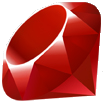Александър обнови решението на 17.12.2013 12:25 (преди почти 12 години)
+module Graphics
+ class Canvas
+ attr_reader :width, :height
+ attr_accessor :canvas
+
+ def initialize(width, height)
+ @width = width
+ @height = height
+ @canvas = Array.new(height) { Array.new(width) }
+ end
+
+ def set_pixel(x, y)
+ @canvas[y][x] = true
+ end
+
+ def pixel_at?(x, y)
+ @canvas[y][x]
+ end
+
+ def draw(figure)
+ if figure.class == Point
+ set_pixel figure.x, figure.y
+ else
+ figure.path.each { |coordinate| set_pixel coordinate[0], coordinate[1] }
+ end
+ end
+
+ def render_as(renderer)
+ renderer.render(self)
+ end
+ end
+
+ module Renderers
+ module Ascii
+ def self.render(canvas)
+ canvas.canvas.map { |row| row.map { |pixel| fill_pixel(pixel) }.join }.join("\n")
+ end
+
+ def self.fill_pixel(pixel)
+ pixel ? '@' : '-'
+ end
+ end
+
+ module Html
+ HEADER = <<-EOS
+ <!DOCTYPE html>
+ <html>
+ <head>
+ <title>Rendered Canvas</title>
+ <style type="text/css">
+ .canvas {
+ font-size: 1px;
+ line-height: 1px;
+ }
+ .canvas * {
+ display: inline-block;
+ width: 10px;
+ height: 10px;
+ border-radius: 5px;
+ }
+ .canvas i {
+ background-color: #eee;
+ }
+ .canvas b {
+ background-color: #333;
+ }
+ </style>
+ </head>
+ <body>
+ <div class="canvas">
+ EOS
+
+ FOOTER = <<-EOS
+ </div>
+ </body>
+ </html>
+ EOS
+
+ def self.render(canvas)
+ HEADER +
+ canvas.canvas.map { |row| row.map { |pixel| fill_pixel(pixel) }.join }
+ .join("<br>\n") +
+ FOOTER
+ end
+
+ def self.fill_pixel(pixel)
+ pixel ? '<b></b>' : '<i></i>'
+ end
+ end
+ end
+
+ class Point
+ attr_reader :x, :y
+
+ def initialize(x, y)
+ @x = x
+ @y = y
+ end
+
+ def eql?(other)
+ x == other.x and y == other.y
+ end
+
+ alias :== :eql?
+ end
+
+ class Line
+ attr_reader :from, :to, :path
+
+ def initialize(from, to)
+ @from, @to = from, to
+ @delta_x, @delta_y = (@to.x - @from.x).abs, -(@to.y - @from.y).abs
+ @step_x, @step_y = (@from.x < @to.x ? 1 : -1), (@from.y < @to.y ? 1 : -1)
+ @err, @x, @y = @delta_x + @delta_y, @from.x, @from.y
+ @path = Set.new [[@x, @y]]
+ set_path
+ end
+
+ def set_path
+ begin
+ @error_2 = 2 * @err
+ correct_x
+ correct_y
+ @path << [@x, @y]
+ end until (@x == @to.x && @y == @to.y)
+ end
+
+ def correct_x
+ if @error_2 >= @delta_y
+ @err += @delta_y
+ @x += @step_x
+ end
+ end
+
+ def correct_y
+ if @error_2 <= @delta_x
+ @err += @delta_x
+ @y += @step_y
+ end
+ end
+
+ def eql?(other)
+ from == other.from and to == other.to
+ end
+
+ alias :== :eql?
+
+ private :set_path, :correct_x, :correct_y
+ end
+
+ class Rectangle
+ attr_reader :left, :right, :top_left, :top_right,
+ :bottom_left, :bottom_right, :path
+
+ def initialize(first, second)
+ @min_x, @max_x = [first.x, second.x].min, [first.x, second.x].max
+ @min_y, @max_y = [first.y, second.y].min, [first.y, second.y].max
+ set_corners
+ set_path
+ end
+
+ def set_corners
+ @top_left = @left = Point.new @min_x, @min_y
+ @top_right = Point.new @max_x, @min_y
+ @bottom_left = Point.new @min_x, @max_y
+ @bottom_right = @right = Point.new @max_x, @max_y
+ end
+
+ def set_path
+ @path = Line.new(@top_left, @top_right).path +
+ Line.new(@top_right, @bottom_right).path +
+ Line.new(@bottom_right, @bottom_left).path +
+ Line.new(@top_left, @bottom_left).path
+ end
+
+ def eql?(other)
+ left == other.left and right == other.right
+ end
+
+ alias :== :eql?
+ end
+end
Още не съм имплементирал #hash-методи, сега работя по въпроса, просто исках да съм сигурен, че съм предал поне едно решение.
